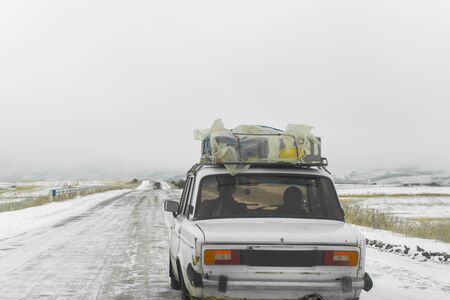1. Understanding Driver Fatigue in Indian Conditions
Driver fatigue is a serious issue on Indian roads, especially during long-distance travel. Unlike many Western countries, India’s unique driving conditions make fatigue even more challenging to manage. Long, monotonous stretches of highway such as the NH44 or Mumbai-Pune Expressway can lull drivers into a false sense of security, leading to drowsiness and slower reaction times. Unpredictable traffic patterns—ranging from sudden jaywalking pedestrians to stray animals and overloaded trucks—demand constant alertness, making mental exhaustion a real concern. The hot and humid climate in most parts of India further adds to driver discomfort, causing dehydration and increasing the risk of tiredness. Additionally, poorly maintained roads with frequent potholes and unclear markings require heightened concentration, quickly wearing down a driver’s focus. Recognizing these local factors is the first step for Indian drivers to understand how easily fatigue can set in, and why staying alert is crucial for safe journeys across the country.
2. Recognising Warning Signs of Sleepiness
For Indian drivers, especially those covering long distances on highways like the Golden Quadrilateral or venturing through rural roads, it’s crucial to identify early signs of drowsiness before it leads to dangerous situations. Knowing how to spot these warning signals can help you pull over and rest before an accident occurs.
Common Symptoms of Driver Fatigue
| Warning Sign | Description | Typical Scenario on Indian Roads |
|---|---|---|
| Loss of Concentration | Difficulty in focusing on the road, missing turnings or traffic signs. | Missing an exit on NH44 or ignoring a speed breaker in a village area. |
| Yawning Repeatedly | Frequent yawning is a clear indicator that your body needs rest. | Yawning multiple times while passing through stretches like the Mumbai-Pune Expressway. |
| Heavy Eyelids | Sensation of your eyes closing involuntarily or blinking more than usual. | Blinking hard or rubbing your eyes while driving during late-night journeys. |
| Frequent Lane Drifting | Unintentionally moving out of your lane, even for a few seconds. | Drifting onto another lane on city flyovers or national highways without realising it. |
When Should You Take Action?
If you notice any of these symptoms, especially in combination, it is a clear signal to take a break immediately. In India’s diverse driving conditions—be it crowded city streets, winding mountain roads, or long expressways—ignoring fatigue can be especially risky due to unpredictable traffic and road hazards.
Quick Self-Check Tips for Indian Drivers:
- Check if you’ve missed recent milestones or toll plazas without remembering them.
- If passengers mention erratic driving or sudden braking, it may be time to stop.
- If you catch yourself “daydreaming” or forgetting the last few kilometres driven, pull over at the next safe dhaba or rest area.
Your Alertness = Everyone’s Safety
Recognising these signs early and taking prompt action is not just about your safety—it’s also about safeguarding passengers, fellow drivers, and pedestrians on India’s busy roads. Don’t ignore the signs; plan regular stops and stay alert throughout your journey.

3. Best Practices for Staying Alert on Indian Roads
Long-distance driving in India presents its own unique set of challenges, from unpredictable weather to bustling highways and rural roads. To stay alert and safe behind the wheel, Indian drivers can benefit from practical, localised strategies that address both fatigue and environmental conditions.
Planned Chai Breaks at Dhabas
One of the most effective ways to combat drowsiness on Indian roads is to schedule regular chai breaks at dhabas. These roadside eateries are not just places for a hot cup of tea; they offer a chance to stretch your legs, interact with fellow travellers, and refresh your mind. Experts recommend stopping every 2-3 hours, especially during long journeys across states like Maharashtra or Tamil Nadu. Sipping on masala chai or cutting chai gives you a caffeine boost and helps break up monotony.
Power Naps: Short Rests for Big Benefits
If you feel your eyelids drooping or concentration slipping, dont hesitate to pull over safely and take a power nap. A 15-20 minute nap at a secure spot—such as a petrol pump parking area or a reputable dhaba—can dramatically improve your alertness and reaction time. Remember, it’s better to arrive late than risk an accident due to driver fatigue.
Local Snacks to Stay Energised
Packing light, energy-boosting snacks commonly available along Indian highways can keep you fuelled without heavy drowsiness. Opt for roasted chana, peanuts, khakra, or banana chips instead of oily meals that may make you sluggish. Hydration is equally important; carry enough bottled water and avoid excessive sugary drinks which can cause an energy crash.
Stay Connected and Share Your Route
Before setting out, share your travel plans with family or friends. Use apps like Google Maps or WhatsApp Live Location so someone always knows where you are. This adds an extra layer of safety if you need help during your journey.
Final Tip: Listen to Your Body
No matter how experienced you are as a driver, always listen to your body’s signals. If you’re feeling tired despite taking breaks and fuelling up with snacks, its wise to find accommodation and rest properly before continuing your trip. Prioritising your well-being ensures safer roads for everyone in India.
4. Safe Journey Planning and Preparation
When embarking on long-distance travel across India, proper planning and preparation are vital for driver alertness and safety. The countrys diverse road conditions, unpredictable traffic patterns, and varying weather demand a thoughtful approach. Below are essential tips tailored for Indian drivers to ensure your journey is safe and fatigue-free.
Importance of Route Planning
Choosing the right route can make a significant difference in your travel experience. In India, certain highways may be under construction, while others might pass through remote areas with limited amenities. Always use reliable navigation apps like Google Maps or MapMyIndia, but also cross-check with local advice, especially during monsoon or festival seasons when routes may be blocked or congested.
Key Factors to Consider When Choosing Your Route
| Factor | Indian Context Example |
|---|---|
| Road Condition | NH44 (smooth), village roads (potholed) |
| Traffic Density | Mumbai-Pune Expressway (heavy on weekends), state highways (less crowded) |
| Amenities Availability | Dhabas on NH8 vs. remote areas with few rest stops |
| Toll Gates & Checkposts | Frequent tolls on major expressways; check FASTag balance beforehand |
| Safety Concerns | Avoid night driving in isolated stretches due to stray animals or poor lighting |
Checking Traffic and Road Conditions
Before starting your trip, always check real-time traffic updates through mobile apps or radio stations. In urban areas like Delhi NCR or Bangalore, rush hours can add hours to your travel time. During festive seasons such as Diwali or Holi, expect heavier traffic on popular routes. Also, monitor weather forecasts as heavy rain can lead to waterlogging or landslides in hilly regions.
Scheduling Rest Stops: The Indian Way
Unlike Western countries where rest areas are well-marked, in India, you need to plan rest breaks at known petrol pumps, highway dhabas, or government-run rest houses (Yatri Niwas). Ideally, plan a 15-20 minute break every 2-3 hours of driving to stretch, refresh yourself, and have some chai. This not only helps fight fatigue but also keeps you alert for the next leg of your journey.
Sample Rest Stop Schedule for a 12-Hour Drive:
| Time Slot (Approx.) | Recommended Activity/Stop Type |
|---|---|
| 0-3 Hours | Coffee/Tea Break at a Dhaba near a major town (e.g., Karnal on Delhi-Chandigarh route) |
| 3-6 Hours | Petrol Pump + Bathroom Break (e.g., Reliance Petrol Pump with clean facilities) |
| 6-9 Hours | Lunch Stop at Highway Restaurant (e.g., A1 Plaza or McDonalds on NH48) |
| 9-12 Hours | Short Nap & Refreshment at Yatri Niwas or similar rest house before resuming journey |
A well-planned trip reduces stress and lowers the risk of fatigue-related incidents. Always inform family or friends about your route and expected arrival time—this is standard practice among seasoned Indian travellers. With thoughtful preparation and regular breaks, you’ll enjoy a safer and more comfortable long-distance drive.
5. Role of Co-Drivers and Passengers
When it comes to long-distance travel on Indian roads, having a co-driver is not just a convenience—it is a smart safety move. Long journeys on highways like the NH44 or winding routes through the Western Ghats can be taxing, especially when dealing with unpredictable weather, uneven road conditions, or heavy traffic. A co-driver can share driving duties, allowing each person to take regular breaks and stay refreshed. This significantly reduces the risk of driver fatigue and microsleep episodes, which are major causes of accidents during extended trips in India.
Why a Co-Driver Makes a Difference
In the Indian context, where journeys often stretch for hours due to tolls, road works, or city congestion, a co-driver’s role becomes even more important. By taking turns behind the wheel every 2–3 hours, both drivers can maintain better concentration and alertness. Moreover, a co-driver can serve as an extra set of eyes—spotting hazards such as stray animals, potholes, or sudden vehicle stops that are common on Indian highways.
Passengers: More Than Just Company
It’s not only the co-driver who can make your trip safer—passengers also play a vital supporting role. Passengers should actively engage with the driver by chatting to keep them alert, sharing snacks and water to ensure everyone stays hydrated and energised, and reminding the driver to stop for chai breaks or power naps if they notice signs of tiredness. A responsible passenger will avoid distracting behaviour and instead help monitor the route using GPS apps or keeping an eye out for signboards in local languages.
Building a Team Approach for Safer Road Trips
Teamwork is key for safe long-distance travel in India. By planning driving shifts in advance and involving everyone in navigation and safety checks, you can turn your journey into a shared responsibility. This approach not only boosts alertness but also makes the trip more enjoyable and stress-free. Remember: whether you’re heading from Delhi to Jaipur or exploring Kerala’s backwaters by road, never underestimate the power of good company and shared vigilance for a safer travel experience.
6. Emergency Solutions and Support Systems
If you find yourself feeling unexpectedly drowsy or fatigued during your journey, it is crucial to act immediately for your safety and that of others on the road.
Do Not Force Yourself to Continue
In India, many drivers try to “push through” tiredness, especially when they are close to their destination. However, this is extremely risky. If you feel sleepy, pull over safely at the nearest dhaba, petrol pump, or rest area. Take a power nap for 15-20 minutes or splash some water on your face. Never underestimate the dangers of microsleep episodes behind the wheel.
Utilise Local Helplines and Assistance
Familiarise yourself with local helpline numbers like the National Highway Helpline (1033) or state-specific emergency services. Many highways have patrol vehicles and emergency call boxes; don’t hesitate to use them if you are unable to continue driving safely. These resources can provide guidance or even arrange for assistance if needed.
Make Use of Roadside Facilities
Indian highways are dotted with rest stops, tea stalls, and community-run facilities where drivers can take breaks. Some major routes offer government-sanctioned “Highway Nests” by NHAI for comfortable short rests. Use these spots to refresh, hydrate, and recover alertness before resuming your drive.
Inform Family or Colleagues
If you’re a commercial driver or travelling in a convoy, inform your employer or fellow drivers about your condition. In case of solo travel, update family members about your location and situation so they can check up on you if required.
Your Safety is Non-Negotiable
Remember: no delivery schedule, family event, or personal deadline is worth risking your life. Indian roads present unique challenges such as unpredictable traffic and varied weather conditions—don’t add fatigue to the mix. Always prioritise rest over haste, and encourage others in your circle to do the same. Safe journeys begin with responsible decisions!

